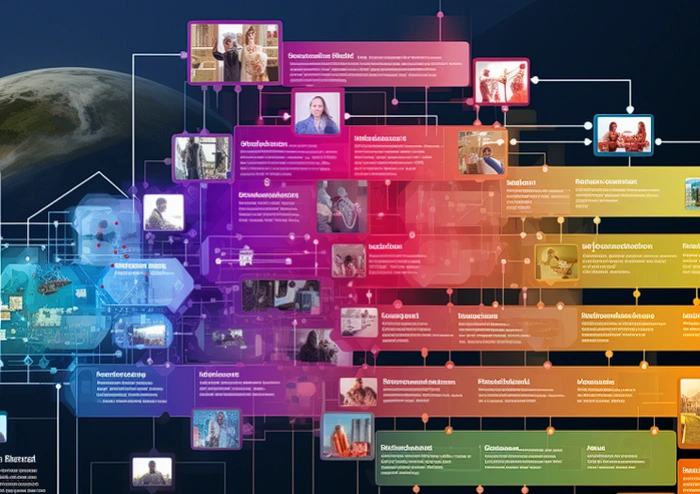The use of advanced engineering frameworks to control the output of AI prompts can be very useful if you are struggling to write prompts yourself or would like to refine a prompt even further. This guide provides an overview of how you can use these frameworks such as Guidance and others.
Initially introduced by Microsoft, Guidance is an open-source framework that empowers users to program the prompt to yield specific output. This framework offers a unique level of control over the final output structure, enabling the construction of the prompt with loops, lists of candidate answers, and if conditions. Advanced AI prompt writing epitomizes this intersection, serving as both an art and a rigorous science.
Guidance
Guidance enables you to control modern language models more effectively and efficiently than traditional prompting or chaining. Guidance programs allow you to interleave generation, prompting, and logical control into a single continuous flow matching how the language model actually processes the text.
Simple output structures like Chain of Thought and its many variants (e.g., ART, Auto-CoT, etc.) have been shown to improve LLM performance. The advent of more powerful LLMs like GPT-4 allows for even richer structure, and guidance makes that structure easier and cheaper.
Before diving deep, it’s crucial to understand the underlying architecture of AI models. Neural networks, particularly transformers like the GPT series, rely on vast amounts of data to generate responses. The prompt serves as a guiding light, directing these models through the maze of information.
Crucial Components:
- Tokens: Every word or character the model processes is considered a token. Managing tokens is essential for optimal performance and cost-efficiency.
- Temperature Settings: This determines the randomness of the AI’s response. A higher value makes outputs more random, while a lower value makes it more deterministic.
- Max Tokens: Setting a limit ensures the response doesn’t exceed a specific length, crucial for applications with space constraints.
Advanced prompt writing framework’s
The versatility of the Guidance framework is truly impressive. It can be used in conjunction with OpenAI’s text DaVinci, GPT-3.5, GP4, or open-source models like Meta’s Llama. This flexibility allows users to define a specific output structure and restrict the actual output the large language model generates, providing a level of precision and control previously unseen in the AI world. Watch the overview video below created by AI Jason to learn more about Guidance and other prompt writing frameworks currently available.
Other articles you may find of interest on the subject of prompt writing :
Advanced techniques in prompt engineering
With a deeper understanding of AI architecture, one can craft prompts that harness the full potential of the model.
Techniques to Master:
- Prompt Chaining: This involves feeding the model’s output back as a new prompt, allowing for extended and more nuanced responses.
- Conditional Prompts: By setting conditions, you can guide the AI’s response more effectively. For instance, “If X, then provide information on Y.”
- Parameter Tuning: Beyond the prompt text, adjusting model parameters like temperature and token limits can significantly affect outputs.
Harnessing feedback for refinement
For those aiming for perfection, iterative refinement is the key. Advanced prompt writers often employ a feedback loop, continuously tweaking their prompts based on AI outputs.
Steps for refinement:
- Analyze the Output: Understand where the response met expectations and where it deviated.
- Tweak the Prompt: Adjust wording, add clarifications, or set conditions.
- Repeat: Feed the adjusted prompt and analyze the new output. Continue this process until the desired result is achieved.
Challenges in advanced prompt writing
Advanced AI prompting isn’t without its challenges. As models grow in complexity, so do the nuances of eliciting the perfect response.
- Overfitting: Overly specific prompts might yield perfect responses in one scenario but fail in others. Striking a balance is essential.
- Cost Implications: More complex prompts might require more tokens, increasing computational costs.
- Unpredictability: Despite advancements, AI responses can sometimes be unpredictable. Continuous testing is crucial.
One of the standout features of the Guidance framework is its ability to set up advanced logic like if conditions in the final output. This feature, coupled with the ability to hide certain parts of the output, can be incredibly useful for internal logic that doesn’t need to be displayed in the final output.
But the capabilities of the Guidance framework don’t stop there. It can also be used to generate emails, create real-time charts with services like Quick Chart, and even generate images with services like Pollinations. This wide range of applications makes it a versatile tool for a variety of industries and use cases.
Features of the Guidance framework
- Simple, intuitive syntax, based on Handlebars templating.
- Rich output structure with multiple generations, selections, conditionals, tool use, etc.
- Playground-like streaming in Jupyter/VSCode Notebooks.
- Smart seed-based generation caching.
- Support for role-based chat models (e.g., ChatGPT).
- Easy integration with Hugging Face models, including guidance acceleration for speedups over standard prompting, token healing to optimize prompt boundaries, and regex pattern guides to enforce formats.
Another noteworthy project is the GPT Prompt Engineer, which leverages GPT to generate and evaluate the quality of prompts. This innovative approach to prompt generation and evaluation further underscores the exciting potential of AI in various fields.
“Prompt engineering is kind of like alchemy. There’s no clear way to predict what will work best. It’s all about experimenting until you find the right prompt. gpt-prompt-engineer is a tool that takes this experimentation to a whole new level.”
The Guidance framework and other similar projects are pushing the boundaries of what’s possible in the realm of AI prompt writing. These advanced AI prompt writing frameworks are not just improving results, but also revolutionizing the way we approach AI and its applications.
Filed Under: Guides, Top News
Latest Aboutworldnews Deals
Disclosure: Some of our articles include affiliate links. If you buy something through one of these links, Aboutworldnews may earn an affiliate commission. Learn about our Disclosure Policy.







